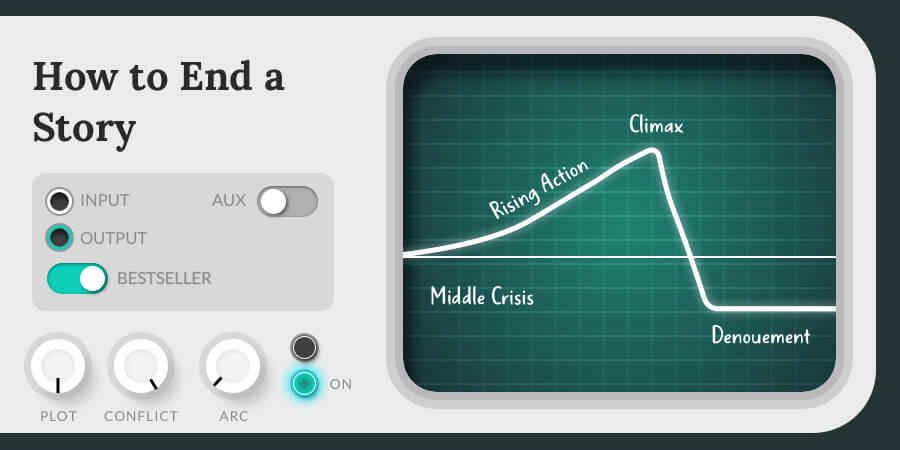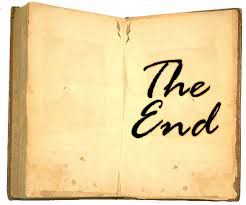Education
In the previous two Aspire issues we've talked about the beginning and the middle of a story. This month, of course, follows with the end. In this article, we're going to talk about how to write a good novel ending, about what makes a good ending. We once again scoured the Internet and found the best tips and tricks to help you along the way.

The ending is an important part of your story, at least as
important as the beginning. While the beginning needs to entice potential readers and reel them in, the ending needs to hold their attention even after the story has finished.
Why? For simple marketing reasons: If the ending of your novel leaves the reader hyped, they will reread your story, talk about it to family, recommend it to friends, leave good reviews on the Internet, etcetera, etcetera. The ending is the part that turns the reader into a fan.
What we found in our research, first and foremost, is that the ending consists of two parts: the climax and the actual ending of the book. When people talk about the end, they might mean either of these two subjects. Therefore we're going to be touching on both subjects in this article.
The climax
The climax is the part where you've built the plot up as high as it goes and everything falls into place. It's the most intense part of the storyline. This part needs to be very thoroughly worked out.
Here are our top tips to make the climax as intense as possible.
Build to an intriguing climax, all the way throughout your story. Your entire story needs to be set up in such a way that the climax pulls all these story-threads together and reveals the big picture. The reader should feel like they've been waiting for this the whole way through.
Your ending needs to make sense from what you've built up to so far. You can't out of nowhere have a demigod come in to save your MC, unless you've built up to this. It needs to make sense from the rest of the story, otherwise your reader will feel cheated.
Avoid clichés. They, too, will make your reader feel cheated. Be creative. Come up with a new and exciting way to handle the conflict. But stay true to your characters while you do it.
Make sure the central conflict of the story is resolved. There can be some loose ends, especially if your story is the first in a series, but even then the central conflict should be resolved. The end needs to be an end.
Aside from the things you should do, there are also a few things you should probably avoid.
Firstly, don't introduce new characters or subplots at this point in the story. You just won't have enough time to explore them properly.
Avoid explaining and musing too much. Focus on the action to keep the tension high during the climax.
And lastly, don't forget your hero. It sounds silly, but it's very important. Don't have side-characters fixing everything for your MC. Your MC should play a vital role in the resolution of the climax. If they're not, the story probably shouldn't be about them!

The Very End
After the climax, you write towards The End. Your MC has conquered the conflict and the resolution has set off. What happens next? How does your story end? There are several ways to end a novel. Here are the ones that are used most often.
Firstly, there's the "happy ever after" ending: the ending that will make your readers feel good. In this version of your ending, tying up loose ends is critical, because if things are left open, the reader might have a nagging feeling that the ending isn't as happy as it seems.
The opposite, of course, is the unhappy ending. The most important thing to remember for an unhappy ending is to make sure the character arcs feel completed. The unhappy event that ends the story needs to feel inevitable, preferably a decision by the MC themselves; they make the tough call despite their best interests.
Then, there's bringing readers full circle; ending where you began. This can be about a physical setting, or meeting the character that the journey started off with, or it could be a spiritual thing. The ending should create an "oh wow!" kind of feeling. Readers love it when some trivial detail from early on turns out to actually be really important towards the end. As long as it's built up throughout the story correctly. Mirroring your final words to the events of the opening scene also tends to work really well.
Another option is the shocking twist ending: surprise the reader in such a way that they feel blown away. Do it right and this will keep the story in their head for a long time, which means you've made a real impact. What's important here is that the twist at the end is surprising, while at the same time doesn't come out of nowhere. You need to build up to it in such a way that the reader doesn't see it coming, but doesn't feel cheated by it. There's a fine balance between preparing the story for the twist and having the twist be a surprise.
Finally there is the open-ended story. This means you leave your ends untied, leaving a lot of things for the reader's imagination. This kind of ending is tricky though, because it needs to be clear that the ending is open by design, rather than because of lazy writing. It needs to feel completed, yet leave loose ends.

Finding it hard to choose between the different options?
Think about how you want your readers to feel after reading your novel. Think about what would follow well on the rest of your story. For example, if you have a happy mood throughout most of the story, an unhappy ending probably wouldn't fit very well.
Whichever option you choose, there are two important things to keep in mind: the ending needs to be clear and it needs to be just. Following these two simple rules will help your ending feel satisfying.
With the ending being clear, we mean that you've answered the question raised by the main plotline and all the subplot questions you've raised along the way. Obviously, this is slightly different with open-ended stories, but usually the questions you've raised also need to be answered.
With the ending being just, we mean that in the end the characters should get what they deserve. The good should be rewarded for all the good they've done, while the evil should be punished in some way. This, like many others, is a rule that may be broken in some situations, but generally this is what readers want to see.

There are several things to watch out for when you get to
The End. To end this article, here are a few top tips for writing towards The End.
First and foremost, think about the effect the climax has had on the lives of your characters. How do their lives change because of the chosen resolution? Because of the things they've done to fix the conflict? Show us the answers to these questions by showing us "the new normal".
Make it clear how your characters' personalities have changed. Plotlines nearly always bring about some kind of change in characters. Maybe your MC is now more forgiving, more open, kinder, maybe a relationship between two of your characters has been broken or mended. Maybe they have a different view on the world, after everything they've been through, or they want different things in life. By showing us this, you tie up the loose end that is your MC.
Leave some room for readers' imagination. Yes, you have to tie up the loose ends, but you can leave a few minor details open for the reader to decide on.
Redemption often plays an important role in the ending. Throughout the story, readers have come to care about your MC in some way or the other. They want to see them succeed. Therefore, it is important that the ending shows some kind of redemption for your MC. No matter how many mistakes have been made along the journey, your novel should show that in the end, they've done the right thing.
Naomi
Team Of Dreams
Bạn đang đọc truyện trên: Truyen247.Pro